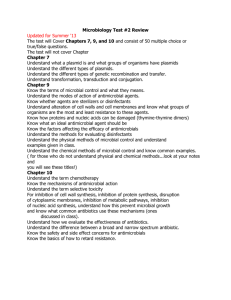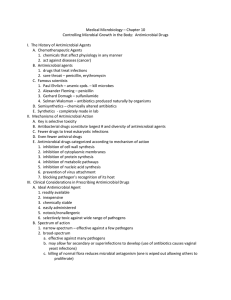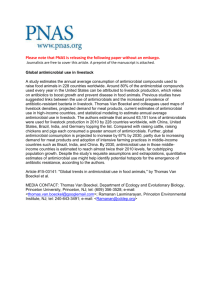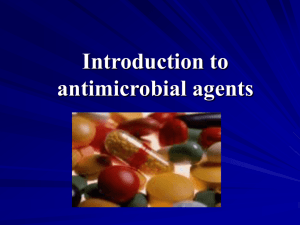Ch 10 Notes
advertisement
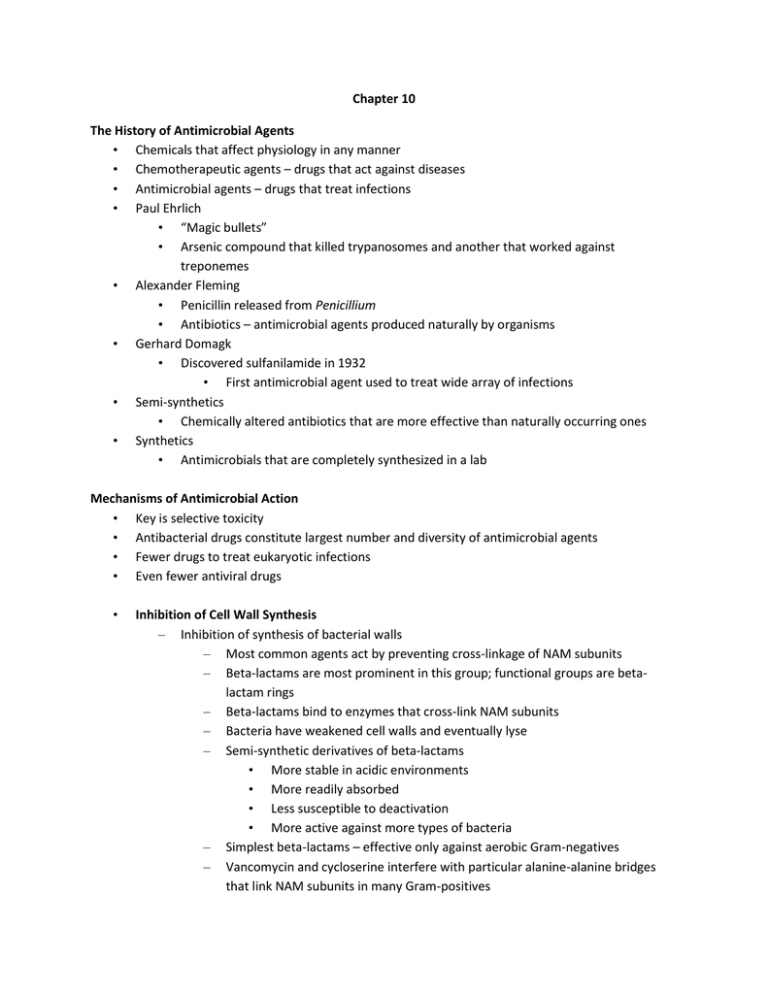
Chapter 10 The History of Antimicrobial Agents • Chemicals that affect physiology in any manner • Chemotherapeutic agents – drugs that act against diseases • Antimicrobial agents – drugs that treat infections • Paul Ehrlich • “Magic bullets” • Arsenic compound that killed trypanosomes and another that worked against treponemes • Alexander Fleming • Penicillin released from Penicillium • Antibiotics – antimicrobial agents produced naturally by organisms • Gerhard Domagk • Discovered sulfanilamide in 1932 • First antimicrobial agent used to treat wide array of infections • Semi-synthetics • Chemically altered antibiotics that are more effective than naturally occurring ones • Synthetics • Antimicrobials that are completely synthesized in a lab Mechanisms of Antimicrobial Action • Key is selective toxicity • Antibacterial drugs constitute largest number and diversity of antimicrobial agents • Fewer drugs to treat eukaryotic infections • Even fewer antiviral drugs • Inhibition of Cell Wall Synthesis – Inhibition of synthesis of bacterial walls – Most common agents act by preventing cross-linkage of NAM subunits – Beta-lactams are most prominent in this group; functional groups are betalactam rings – Beta-lactams bind to enzymes that cross-link NAM subunits – Bacteria have weakened cell walls and eventually lyse – Semi-synthetic derivatives of beta-lactams • More stable in acidic environments • More readily absorbed • Less susceptible to deactivation • More active against more types of bacteria – Simplest beta-lactams – effective only against aerobic Gram-negatives – Vancomycin and cycloserine interfere with particular alanine-alanine bridges that link NAM subunits in many Gram-positives – – • • • • Bacitracin blocks secretion of NAG and NAM from cytoplasm Isoniazid and ethambutol disrupt formation of arabinogalactan-mycolic acid in mycobacterial species – Prevent bacteria from increasing amount of peptidoglycan – Have no effect on existing peptidoglycan layer – Effective only for growing cells – No effect on plant or animal cells; no peptidoglycan Inhibition of Protein Synthesis – Prokaryotic ribosomes are 70S (30S and 50S) – Eukaryotic ribosomes are 80S (40S and 60S) – Drugs can selectively target translation – Mitochondria of animals and humans contain 70S ribosomes; can be harmful Disruption of Cytoplasmic Membranes – Some drugs become incorporated into cytoplasmic membrane and damage its integrity – Amphotericin B attaches to ergosterol in fungal membranes • Humans somewhat susceptible because cholesterol similar to ergosterol • Bacteria lack sterols; not susceptible – Azoles and allyamines inhibit ergosterol synthesis – Polymyxin disrupts cytoplasmic membranes of Gram-negatives; toxic to human kidneys – Some parasitic drugs act against cytoplasmic membranes Inhibition of Metabolic Pathways – When differences exist between metabolic processes of pathogen and host, antimetabolic agents can be effective – Quinolones interfere with the metabolism of malaria parasites – Heavy metals inactivate enzymes – Agents that disrupt tubulin polymerization and glucose uptake by many protozoa and parasitic worms – Drugs block activation of viruses – Metabolic antagonists – Trimethoprim binds to enzyme involved in conversion of dihydrofolic acid to THF – Humans obtain folic acid from diet; metabolism unaffected – Antiviral agents can target unique aspects of viral metabolism • Amantadine, rimantadine, and weak organic bases neutralize acidity of phagolysosome and prevent viral uncoating – Protease inhibitors interfere with an enzyme (protease) that HIV needs in its replication cycle Inhibition of Nucleic Acid Synthesis – Several drugs function by blocking DNA replication or mRNA transcription – Only slight differences between prokaryotic and eukaryotic DNA; drugs often affect both types of cells – Not normally used to treat infections; used in research and perhaps to slow cancer cell replication – – • Compounds can interfere with function of nucleic acids (nucleotide analogs) Nucleotide Analogs can distort shapes of nucleic acid molecules and prevent further replication, transcription, or translation – Most often used against viruses; viral DNA polymerases more likely to incorporate and viral nucleic acid synthesis more rapid than that in host cells – Also effective against rapidly dividing cancer cells – Quinolones and fluoroquinolones act against prokaryotic DNA gyrase; little effect on eukaryotes or viruses – Other drugs, including rifampin, bind to and inhibit action of RNA polymerase during transcription – Reverse transcriptase inhibitors act against the enzyme, reverse transcriptase, an enzyme HIV uses in its replication cycle • Inhibitor does not harm people because humans lack reverse transcriptase Prevention of Virus Attachment – Attachment can be blocked by peptide and sugar analogs of attachment or receptor proteins (attachment antagonists) – New area of antimicrobial drug development Clinical Considerations in Prescribing Antimicrobial Drugs • Ideal Antimicrobial Agent – Readily available – Inexpensive – Chemically stable – Easily administered – Nontoxic and nonallergenic – Selectively toxic against wide range of pathogens • Spectrum of Action – Broad-spectrum antimicrobials may allow for secondary or superinfections to develop – Killing of normal flora reduces microbial antagonism • Efficacy – Ascertained by • Diffusion susceptibility tests • Minimum inhibitory concentration test • Minimum bactericidal concentration test • Routes of Administration – Topical application of drug if infection is external – Oral – simplest; lower drug concentrations; no reliance on health care provider; patients do not always follow prescribing information – Intramuscular – requires needle; concentration never as high as IV administration – Intravenous – requires needle or catheter; drug concentration diminishes as liver and kidneys remove drug from circulation – Must know how antimicrobial agent will be distributed to infected tissues • Safety and Side Effects – Toxicity • Exact cause of many adverse reactions poorly understood • Drugs may be toxic to kidneys, liver, or nerves • Considerations needed when prescribing drugs to pregnant women – Allergies • Although allergic reactions are rare, they may be life threatening – Disruption of normal microbiota • May result in secondary infections • Overgrowth of normal flora – superinfections • Of greatest concern for hospitalized patients Resistance to Antimicrobial Drugs • Mechanisms of Resistance – At least six mechanisms of resistance – Resistant cells may produce an enzyme that destroys or deactivates the drug – Microbes may slow or prevent the entry of the drug into the cell – Alter the target of the drug so it cannot attach or binds less effectively – Alter their metabolic chemistry – Pump the antimicrobial out of the cell before it can act – Mycobacterium tuberculosis produces MfpA protein, which binds to DNA gyrase preventing the binding of fluoroquinolone drugs • Multiple Resistance and Cross Resistance – Pathogen can acquire resistance to more than one drug at a time – Common when R-plasmids exchanged – Develop in hospitals and nursing homes; constant use of drugs eliminates sensitive cells – Superbugs – Cross resistance • Retarding Resistance – High concentration of drug maintained in patient long enough to kill all sensitive cells and inhibit others so immune system can destroy – Use antimicrobial agents in combination; synergism vs. antagonism – Limit use of antimicrobials to necessary cases – Develop new variations of existing drugs – Second-generation drugs – Third-generation drugs – Search for new antibiotics, semi-synthetics, and synthetics – Bacteriocins – Design drugs complementary to the shape of microbial proteins to inhibit them
